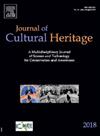当代油画表面白化现象的多重分析方法及其在金属皂中的应用
IF 3.3
2区 综合性期刊
0 ARCHAEOLOGY
引用次数: 0
摘要
本研究提出了一种多分析方法,用于表征在油漆表面形成白雾的降解产物。巴斯克当代著名画家桑托斯Iñurrieta(1950 ~ 2023)的油画《无题》(1971)的表面被选为代表性作品。表面白化现象的出现是油画保护中的一个主要问题,由于其来源可能非常多样化,因此对其进行鉴定是一项挑战。为了表征Untitled(1971)上的白色物质并了解其形成,进行了全面检查,包括放射照相和紫外线诱导荧光,然后根据应用的诊断技术对不同类型的微样品进行分析:油漆碎片、横断面或表面刮痕。该方法包括对上述样品的几种技术的应用:数字显微镜(DM)、光学显微镜(OM)、扫描电子显微镜-能量色散光谱(SEM-EDX)、x射线计算机断层扫描(CT)、微x射线荧光(µ-ED-XRF)、拉曼光谱、衰减全反射-傅里叶变换红外光谱(ATR-FTIR)、x射线衍射(XRD)、气相色谱-质谱(GC-MS)和x射线光电子能谱(XPS)。提出的方法鉴定出含铅皂(棕榈酸酯和硬脂酸酯)是油漆表面变白的主要原因。此外,它还提供了艺术家使用的材料和技术的信息,并揭示了铅源可能是铅干燥器。因此,这项工作是为了解决当代艺术保护中目前最重要的问题之一而向前迈出的一步,为有效去除不同的美白现象提供了相关信息。本文章由计算机程序翻译,如有差异,请以英文原文为准。

A multi-analytical approach for the identification of surface whitening phenomena in contemporary oil painting and its application to metal soaps
This research presents a multi-analytical approach for the characterization of the degradation products that form white hazes on paint surfaces. The surface of Untitled (1971), an oil painting by Santos Iñurrieta (1950–2023), one of the most noteworthy contemporary Basque artists, was chosen as a representative example. The appearance of surface whitening phenomena is a major issue in oil painting conservation and their identification represents a challenge since their origin can be very diverse. In order to characterize the white substance over Untitled (1971) and understand its formation, a global examination was performed, including radiography and UV induced fluorescence, followed by the analysis of different types of microsamples according to the diagnostic technique applied: paint fragments, cross-sections or surface scrapings. The methodology included the application of several techniques on the aforementioned samples: Digital Microscopy (DM), Optical Microscopy (OM), Scanning Electron Microscopy-Energy Dispersive Spectroscopy (SEM-EDX), X-ray Computed Tomography (CT), micro X-Ray Fluorescence (µ-ED-XRF), Raman Spectroscopy, Attenuated Total Reflection-Fourier Transform Infrared spectroscopy (ATR-FTIR), X-ray Diffraction (XRD), Gas Chromatography-Mass Spectrometry (GC–MS) and X-ray Photoelectron Spectroscopy (XPS). The proposed approach resulted in the identification of lead soaps (palmitate and stearate) as the primary cause for the whitening of the painting surface. Additionally, it provided information of the materials and techniques employed by the artist and revealed that the lead source was probably a lead drier. Thus, this work is a step forward in order to deal with one of the most significant problems currently being addressed in contemporary art conservation, providing relevant information for the efficient removal of the different whitening phenomena.
求助全文
通过发布文献求助,成功后即可免费获取论文全文。
去求助
来源期刊

Journal of Cultural Heritage
综合性期刊-材料科学:综合
CiteScore
6.80
自引率
9.70%
发文量
166
审稿时长
52 days
期刊介绍:
The Journal of Cultural Heritage publishes original papers which comprise previously unpublished data and present innovative methods concerning all aspects of science and technology of cultural heritage as well as interpretation and theoretical issues related to preservation.
 求助内容:
求助内容: 应助结果提醒方式:
应助结果提醒方式:


